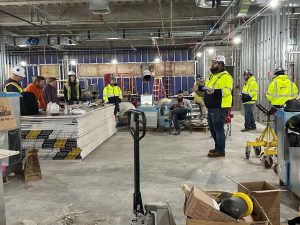When a Mid-City Electric foreman died by suicide in March 2022, it came as a surprise to the Westerville-based electrical contractor.

“He had a wife and four kids, and it seemed like he was doing OK,” said Paul Lawson, Risk Management Coordinator & Lead Mental Health Advocate at Mid-City. “When he died, we were all completely shocked and devastated.”
Following the incident, Mid-City started researching whether occurrences like this were happening elsewhere and discovered that construction has the highest suicide rate of all industries at 53.2 suicides per 100,000 workers, according to the Centers for Disease Control and Prevention.
In the past year and a half, an initiative developed at Mid-City addressing the need for mental health, addiction and suicide prevention and education in construction has grown into a partnership with the Builders Exchange of Central Ohio as well as the Alcohol, Drug and Mental Health Board of Franklin County (ADAMH).
Why are construction workers at risk?
Ameena “Dr. K.” Kemavor, ADAMH Vice President of Advocacy & Engagement, said the nature and demand of the construction industry lends itself to having the highest rates of suicides than any other industry.
Common risk factors associated with construction’s high-pressure work environment include the long hours, high prevalence of alcohol and substance misuse and extended time away from family.
“If you go another layer deeper, we know that construction is a male-dominated industry and societally, at least in America, men are socialized to hold their emotions in, so you might see some unhealthy coping strategies,” Dr. K. said.
Not only has stress and psychosocial factors contributed to workers’ decline in mental health, but construction workers are also more likely to die of overdose than those in any other line of work, according to the CDC.
Construction jobs are often hard on workers’ bodies, making them susceptible to injury. A third of construction workers have muscle or bone ailments, which make them three times as likely to be prescribed opioids for pain. According to an article from the New York Times, construction workers also do not often get paid sick leave, which could make opioids an option for getting back to work quickly.
But most of this information isn’t new to the Builders Exchange audiences Dr. K. presents to, she said. The Builders Exchange is a commercial construction trade association that advances the commercial construction industry as the resource for communication, education, services and recognition. It’s comprised of nearly 650 firms with membership ranging from architects, engineers, general contractors and subcontractors, to related professionals such as attorneys, bankers, accountants and computer specialists.
“The construction companies I have been engaging with are already addressing wellness initiatives, so it's wonderful to know that it's a true collaboration and they just want an expert to come in and talk about a topic in a way that maybe they’re not equipped enough to talk about,” Dr. K. said.
Transforming construction culture and safety education
Paul said the first hurdle to getting a well-being program off the ground was making it stick.
"Mid-City leadership has been supportive since day one, but early on, I did hear from around the industry that well-being programs in construction don't work because of culture," he said. "But I couldn't stand by and let stigma keep us from talking about well-being and ignoring issues because it's awkward and uncomfortable. To me, that excuse is insulting to the grieving families who have been affected by our suicide rate. We decided to do the right thing by believing our industry can be healthier and building our program from the ground up.”
What started as a couple construction site visits talking to a handful of workers about mental health and well-being turned into a constant stream of speaking engagements, suicide prevention trainings and interest from other companies to learn more about how to get involved.

It didn’t take long for Paul to connect with Ashton Chapman, Builders Exchange Director of Safety Education, who was working to expand what “safety education” in construction meant.
“Safety education is very regulatory, which is obviously very good, but I think a lot of times, these (health and safety) positions tend to only focus on that initial physical safety aspect of our job and let go of the health-side of things,” Ashton said.
Ashton said safety education needs have changed since the pandemic, which is why the Builders Exchange wants to make sure the mental health and wellness piece is included going into a “new frontier of safety,” a saying Ashton credits to Paul.
“What we’re sharing is missioned-based and transformative for the industry,” Paul said. “(Ashton and I) kept coming back to this idea of having a separate sub-council that’s totally focused on well-being, which is how the Builders Exchange of Central Ohio Blueprints for Well-being Council came about.”
The council aims to touch on different corners in the construction industry – physical, mental and nutritional health, construction safety, Employee Assistance Program benefits and more – through trainings, discussions and speaking engagements.
“We're trying to create a consistent community of people who just want come in and be a part of this stuff, and I think that’s what hopefully the council is and can become and continue to be; a home for those people, those thoughts and those changes that we want to enact within the industry,” Ashton said.
Utilizing ADAMH as a local resource, plans to expand well-being initiative
Since the early days of Paul’s well-being presentations, he’s highlighted ADAMH and its network of providers as a local resource for workers to take advantage of.
When the Builders Exchange of Central Ohio Blueprints for Well-being Council was created, Paul knew he wanted Dr. K. to present at its first meeting. Since her initial presentation on mental health and opioid addiction in the construction industry, Dr. K. has continued to spread her expertise on behavioral health in the workplace by speaking to other Builders Exchange companies. She’s spoken to hundreds of construction workers about help-seeking behavior, safety ties to mental health in the workplace and more.
“Hearing that Dr. K. has been pulled in other directions is exactly what we wanted to see happen,” Paul said. “It’s just finding more ways we can highlight the work ADAMH does and really put them on the platform as the local resource.”

The council will continue to lean on ADAMH as a local well-being resource at the upcoming presentation, “A Call To Action On Opioids In Construction,” on May 8. In collaboration with Cal Beyer, senior director of SAFE (Stop the Addiction Fatality Epidemic) Workplaces for national nonprofit SAFE Project, ADAMH and ADAMH providers CompDrug and Southeast Healthcare will discuss preventative strategies for addressing the opioid crisis in construction.
“I think it’s amazing that the council is keeping this well-being conversation going by tapping into all of these different points of risk for construction workers, and I’m really excited they keep inviting us to be a part of it,” Dr. K. said.
Beyond central Ohio, Paul and the council are working alongside the Ohio Suicide Prevention Foundation to possibly create statewide well-being initiatives for blue-collar trades. As the initiative grows, Paul hopes it can turn into something useable for the construction industry nationwide.
“This is work that I think is revolutionary for construction,” he said. “I think that if we build community and help companies not see each other as competitors but as allies in this topic, I think we’ll completely change the foundations of the industry.”
View coverage from WOSU Public Media.
If you have thoughts of suicide or are in crisis, call, text or chat the 988 Suicide & Crisis Lifeline immediately.
